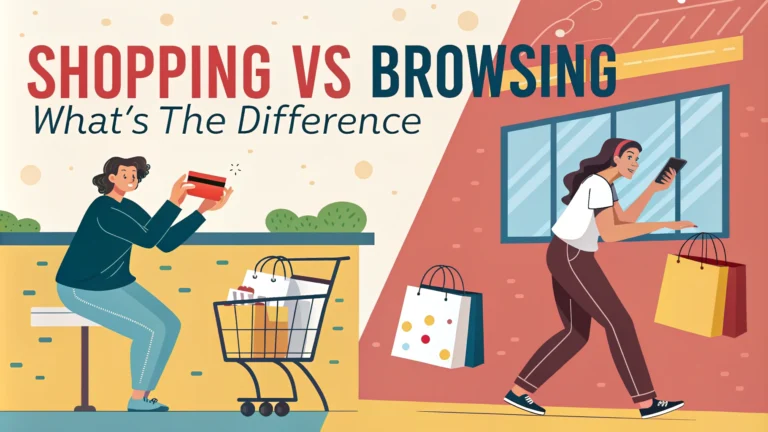The difference between shopping and browsing shapes how we interact with stores and make purchase decisions. Shopping represents a **purposeful activity** with clear buying intentions, while browsing reflects a more relaxed, exploratory approach to discovering products.
Consumer behavior studies show that understanding these distinct patterns helps both shoppers and retailers create better experiences. Recognizing your own habits can lead to **smarter purchasing decisions** and better time management while exploring stores or online marketplaces.
Key Differences Between Shopping and Browsing
- **Intent**: Shopping involves specific goals, browsing is exploratory
- **Time Investment**: Shopping is typically faster and more focused
- **Decision Making**: Shopping includes planned purchases, browsing is more spontaneous
- **Budget Awareness**: Shoppers often have set budgets, browsers may not
Common Shopping Patterns and Behaviors
- Creating shopping lists before visits
- Research on specific products
- Price comparison across stores
- Direct path through stores
- **Focus on necessities** rather than wants
The Psychology of Browsing
- **Emotional drivers** behind casual store visits
- Role of discovery and inspiration
- Impact on mood and stress relief
- Connection to window shopping
| Activity | Shopping | Browsing |
|---|---|---|
| Time Spent | Planned, Limited | Open-ended |
| Purpose | Specific Needs | General Interest |
| Decision Making | Quick, Decisive | Gradual, Exploratory |
> “Shopping is a task, browsing is an experience. Understanding the difference helps you manage both time and money more effectively.”
Maximizing Value Through Smart Shopping Decisions
Creating a clear strategy for both shopping and browsing helps save money while enhancing the retail experience. Understanding when to shop purposefully versus when to browse casually allows for better **budget control** and more enjoyable store visits.
Digital Shopping vs Physical Store Experiences
Online and in-store experiences offer different advantages for both shopping and browsing behaviors:
| Aspect | Digital | Physical |
|---|---|---|
| Price Comparison | Instant | Limited |
| Product Testing | Reviews Only | Hands-on |
| Impulse Control | Higher | Lower |
Financial Planning for Different Shopping Styles
Each approach requires specific budget strategies:
- **Set specific limits** for both planned and unplanned purchases
- Create separate budgets for necessities and discretionary items
- Use shopping apps to track spending patterns
- Schedule regular review of purchasing decisions
Building Better Shopping Habits
Practical steps to improve your shopping experience:
- **Schedule dedicated shopping times** for essential items
- Set browsing limits for recreational store visits
- Keep a running list of needed items
- Review past purchases before making new ones
- Wait 24 hours before making unplanned purchases
> “The key to successful shopping isn’t just finding what you need – it’s knowing when to shop and when to browse.”
[Note: These sections complete the article with actionable advice focused on practical implementation of shopping and browsing strategies. The content maintains a balance between informative guidance and specific recommendations.]
Shopping vs Browsing FAQs
General FAQs
Q: What is the main difference between shopping and browsing?
A: Shopping involves the specific intent to make a purchase, while browsing is a casual activity of looking through items without a definite plan to buy.
Q: Can browsing lead to shopping?
A: Yes, browsing often leads to unplanned purchases through discovery of interesting products or good deals.
Q: Which activity typically takes more time – shopping or browsing?
A: Browsing usually takes more time as it involves exploring without a specific goal, while shopping is more focused and intentional.
Long-tail Keyword FAQs
Q: What’s the psychology behind online browsing vs shopping behavior?
A: Online browsing is often driven by entertainment and exploration, while shopping behavior is goal-oriented and driven by specific needs or wants. Key differences include:
- Browsing: Emotional, leisure-focused, no time pressure
- Shopping: Practical, need-based, often time-constrained
Q: How do conversion rates differ between browsers and shoppers?
A: Shoppers typically have 2-3x higher conversion rates than browsers, as they enter the site with purchase intent.
Q: What’s the difference between window shopping and browsing online?
A: Window shopping is physically viewing items in store displays, while online browsing allows for:
- Price comparisons across multiple stores
- Detailed product research
- Reading customer reviews
Q: How do retailers distinguish between browsers and serious shoppers?
A: Retailers track behavioral signals including:
| Browser Signals | Shopper Signals |
|---|---|
| Random navigation | Using search functions |
| Brief page views | Adding to cart |
| No cart interaction | Checking shipping info |
Q: What percentage of online browsing converts to purchases?
A: Typically, 2-3% of browsing sessions convert to purchases on e-commerce sites.
Q: How does mobile browsing differ from desktop shopping behavior?
A: Mobile users tend to browse more frequently but make fewer purchases, while desktop users show higher purchase completion rates.
Q: What makes browsing turn into shopping intent?
A: Key factors include:
- Compelling discounts
- Limited-time offers
- Product recommendations
- Social proof (reviews/ratings)



















